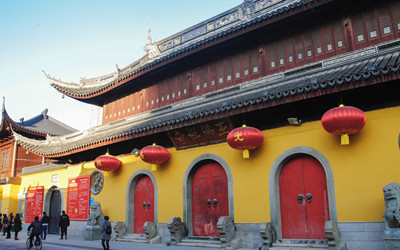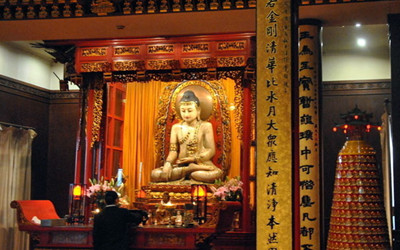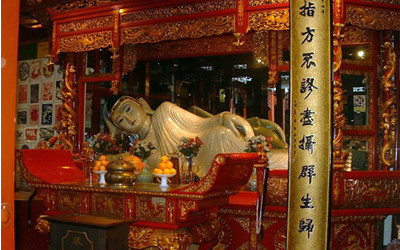
Shanghai Jade Buddha Temple
Jade Buddha Temple is a famous historical site in Shanghai, as well as a Buddhist temple famed by large jade Buddha statue which is located in a crowd of Shanghai City. The temple is one of the Shanghai must-see attractions, and it is an active one that with 70 resident monks at last count. This famous temple receives thousands of visitors and worshipers everyday and now becomes a must-see attraction during Shanghai tour.
History of the Jade Buddha Temple
 Jade Buddha Temple was first built in 1882 in Jiangwan on the southern outskirts of Shanghai. At that time, a 1.9-metre-high white jade Buddha was installed here after a monk had brought it from Burma to Zhejiang Province in 1882. In order to make it convenient for the adherents to visit, it was bodily moved to Shanghai City at the present sire in 1918.
Jade Buddha Temple was first built in 1882 in Jiangwan on the southern outskirts of Shanghai. At that time, a 1.9-metre-high white jade Buddha was installed here after a monk had brought it from Burma to Zhejiang Province in 1882. In order to make it convenient for the adherents to visit, it was bodily moved to Shanghai City at the present sire in 1918.During the era of Emperor Guang Xu in the Qing Dynasty (1875–1908), Hui Gen, an abbot from Mount Putuo went on a pilgrimage to Tibet via the two famous Chinese mountains Mount Wutai and Mount Emei. After Tibet, he proceeded to India and then arrived in Burma. While in Burma, Mr. Chen Jun-Pu, an overseas Chinese resident in Burma, donated funds to seek for the high-quality jade stones, which were carved into five jade Buddha statues afterwards. Hui Gen then transported the statues back to China. When he traveled via Shanghai, two of the statues were left in JiangWan Town, Shanghai, one is seated Buddha and the other is reclining Buddha. Here Hui Gen had a temple built with donated funds, to consecrate the Buddha statues, and he died shortly thereafter. This temple was occupied during the 1911 uprising, and the statues were moved to Maigen Road. In 1918, the original temple was destroyed in a war. Then the temple was rebuilt at the current site by Ke Chen later, donated by Sheng, Xuanhuai. Mr. Sheng Huaixuan was a senior official in the Qing court, and his father and his uncle were pious Buddhist disciples. The reconstruction took ten years, and lasted from 1918-1928. After it was finished, it was renamed as “Jade Buddhist Temple”. Ke Chen also invited Reverend Di Xian from Tian Tai mountain to come and lecture on Buddhism in a magnificent ceremony.
In 1955, the 14th Panchen visited the temple. In 1956, a ceremony was held at the temple by the Shanghai Buddhist Association to celebrate the 2500th anniversary of Gautama Buddha's enlightenment. On January 8, 1963, The Premier Zhou Enlai accompanied prime minister of Ceylon (now Sri Lanka) Mrs. Bandaranaike to visit Jade Buddha Temple.
 In 1966-1976, during the Cultural Revolution, the monks made a living by selling handicrafts. But the two jade Buddha statues and many rare and precious cultural relics were intactly protected. It was the only complete preserved Buddhist monastery in Shanghai during the Cultural Revolution. In 1978, the temple was reopened to the public.
In 1966-1976, during the Cultural Revolution, the monks made a living by selling handicrafts. But the two jade Buddha statues and many rare and precious cultural relics were intactly protected. It was the only complete preserved Buddhist monastery in Shanghai during the Cultural Revolution. In 1978, the temple was reopened to the public.In 1979, Master Zhenchan was recommended to be the 10th abbot of the temple. With his effort, the monastery went renewed. Since 1981, various legal activities were held in the temple, and proceed a positive start of printing and circulation of some scriptures .In 1983, Shanghai Institute of Buddhism was established at the temple under the Shanghai Buddhist Association.
In 1985, Monk Zhizhi Xuan and others made a trip to Dunhuang via Xinjiang. Shortly after their return, regular scripture lectures, meditation and other features of temple life were resumed.Since then, this temple becomes more and more popular to the public.
What to see?
 The most famous thing of Jade Buddha Temple is not the architectural idea which was conveyed in Song Dynasty, the valuable essence lies in the Buddha figures. The seated Buddha, encrusted with jewels, is said to weigh 1,000 kg. A smaller, reclining Buddha from the same shipment lies on a redwood bed. There are three gold-plated Buddhas in the large hall and other halls house ferocious-looking deities.
The most famous thing of Jade Buddha Temple is not the architectural idea which was conveyed in Song Dynasty, the valuable essence lies in the Buddha figures. The seated Buddha, encrusted with jewels, is said to weigh 1,000 kg. A smaller, reclining Buddha from the same shipment lies on a redwood bed. There are three gold-plated Buddhas in the large hall and other halls house ferocious-looking deities.Artifacts abound, not all on display, and some 7,000 Buddhist sutras line the walls. Also in the precincts is a branch of the Antiques & Curio Store that sells miniature sandalwood drums and gongs, replicas of the large ones used in ceremonies. No photography of the Jade Buddha is permitted, but postcards are available.
Travel Tips
Add: 170 Anyuan Rd., Jing'an District, Shanghai, China
Opening Hours: 08:00-16:30






 Ask Questions ?
Ask Questions ?